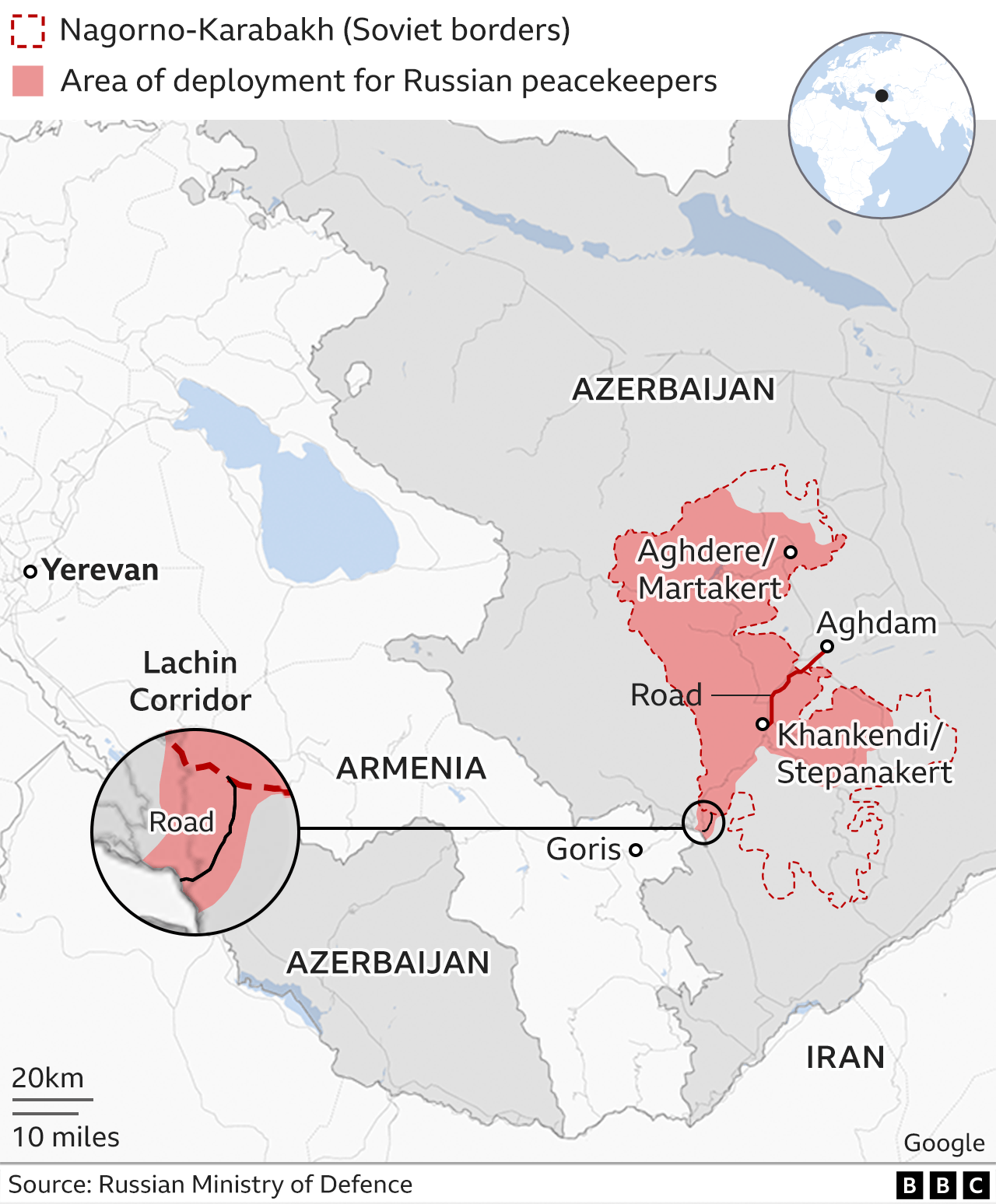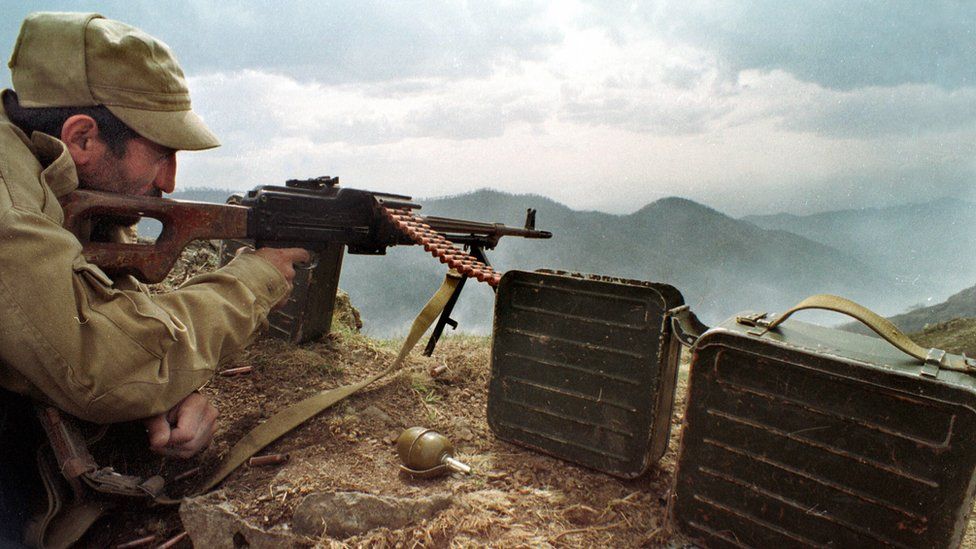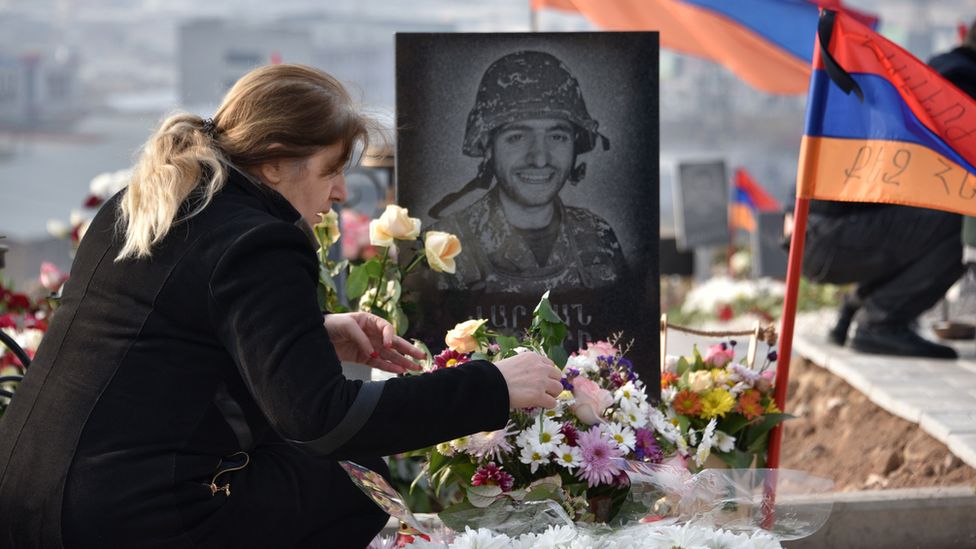BBC News 20 September 2023
Azerbaijan and ethnic Armenians in the breakaway region of Nagorno-Karabakh have declared a ceasefire, 24 hours after Azerbaijan launched a military offensive.
Under the agreement, ethnic-Armenian forces in Nagorno-Karabakh will be disbanded and completely disarmed.
The territory is recognised internationally as part of Azerbaijan but large areas of it have been controlled by ethnic Armenians for three decades.
Where is Nagorno-Karabakh?
The territory lies in the mountainous South Caucasus region of Eastern Europe and Asia between the Black Sea and the Caspian Sea.
Azerbaijan and Armenia fought a bloody war over Nagorno-Karabakh in the late 1980s and early 1990s, and it has been the trigger for further violence in the years since.
The last major escalation in the conflict took place in 2020 when thousands of people were reported killed in six weeks of fierce fighting.
The deployment of Russian peacekeepers brought the fighting to a halt at the time, but tensions had been ratcheting up for months ahead of the latest military operation.
What led to the latest fighting?
Fears of fresh violence came when Azerbaijan mounted an effective blockade of a vital route into the enclave in December 2022.
The Lachin Corridor is the only road that connects the Republic of Armenia to the roughly 120,000 ethnic Armenians in Nagorno-Karabakh.
It is a key artery for supplies, and residents in Nagorno-Karabakh reported severe shortages of basic food items and medication in recent months.
Azerbaijan accused Armenia of using the road to bring in military supplies, which Armenia denied.
Armenia-Azerbaijan: Nagorno-Karabakh map
Observers reported a build-up of Azerbaijani troops during the blockade, but that was in turn denied in Baku.
Hopes that tensions might ease came when a small number of aid trucks operated by the International Committee of the Red Cross were allowed into Nagorno-Karabakh in mid-September through the Lachin Corridor and, separately, the Aghdam Road from Azerbaijan.
But keeping these transport links open, in particular the Lachin Corridor, relied heavily on the presence of Russian peacekeepers deployed in the area since 2020.
And Moscow's attention and military resources have been diverted by its invasion of Ukraine. The Armenian prime minister said recently that Russia was "spontaneously leaving the region".
What led to war?
Modern-day Armenia and Azerbaijan became part of the Soviet Union in the 1920s.
The area designated Nagorno-Karabakh had a majority ethnic-Armenian population but was controlled by Azerbaijan.
Nagorno-Karabakh's regional parliament voted to become part of Armenia when the Soviet Union began to collapse in the late 1980s.
Azerbaijan sought to suppress the separatist movement, while Armenia backed it.
This led to ethnic clashes and - after Armenia and Azerbaijan declared independence from Moscow - a full-scale war.
Years of bloodshed and suffering followed.
BBC Azerbaijani Service editor Konul Khalilova remembers how hundreds of thousands of ethnic Azerbaijanis were forced out of Armenia, becoming refugees in Azerbaijan.
In February 1992, residents of the Azerbaijani town Khojaly, situated in the Nagorno-Karabakh area, were killed by Armenian forces, helped by some of the Russian military. More than 600 people died, according to Azerbaijan. Armenia disputes the account and the number of deaths.
Over the years, tens of thousands of people were killed and more than a million displaced amid reports of ethnic cleansing and massacres committed by both sides.
Khalilova says it sometimes surprises her how little young people in both countries know about the atrocities.
No-one tells Armenians about the Azerbaijanis who were killed; likewise, young Azerbaijanis today do not hear about pogroms of the Armenian people in Azerbaijani cities such as Sumgayit and Baku at the end of the 1980s, she says.
Azerbaijan disputes the accounts of pogroms.
The first Nagorno-Karabakh war ended with a Russian-brokered ceasefire in 1994, after Armenian forces had gained control of Nagorno-Karabakh and areas adjacent to it.
Under the deal, Nagorno-Karabakh remained part of Azerbaijan, but since then it has mostly been governed by a separatist, self-declared republic, run by ethnic Armenians and backed by the Armenian government.
What happened in 2020?
The situation has been volatile ever since, with bouts of fighting interrupting periods of relative calm.
The biggest military confrontation since the early 1990s happened three years ago during six weeks of heavy fighting.
Azerbaijan won back territory and by the time both sides agreed to sign a Russian-brokered peace deal in November 2020, it had recaptured all the territories surrounding Nagorno-Karabakh held by Armenia since 1994.
Under the agreement, Armenian forces had to withdraw from these areas and have since been confined to a smaller part of the region.
Who do Russia and Turkey support?
Regional powers have been heavily involved in the conflict over the years.
Nato-member Turkey was the first nation to recognise Azerbaijan's independence in 1991 and has remained a staunch supporter of the country.
Turkish-made Bayraktar drones are said to have played a crucial role in the fighting in 2020, allowing Azerbaijan to make territorial gains.
Armenia, on the other hand, traditionally had good relations with Russia. There is a Russian military base in Armenia, and both are members of the Collective Security Treaty Organization (CSTO) military alliance of six former Soviet states.
But relations between Armenia and Russia have soured since Nikol Pashinyan, who led huge anti-government protests in 2018, became Armenia's prime minister.
He recently said Armenia's reliance on Russia as its single source for security was a "strategic error".
Armenia then announced this month it was hosting joint exercises with US forces which were criticised by Moscow as "unfriendly steps".
President Vladimir Putin denied Armenia had broken off its alliance with Russia, but declared that Yerevan had "essentially recognised" Azerbaijan's sovereignty over Nagorno-Karabakh.
"If Armenia itself recognised that Karabakh is part of Azerbaijan, what should we do?" he said during an economic forum in Vladivostok.
What next?
Azerbaijani forces reportedly made rapid advances in the 24 hours of fighting that erupted on 19 September.
The authorities in Nagorno-Karabakh and Azerbaijan then announced both sides had agreed to a ceasefire mediated by Russia.
The agreement said Karabakh's military forces would be completely disarmed and disbanded.
There will now be talks about the integration of the enclave into Azerbaijan. The outcome of these negotiations will be pivotal for Nagorno-Karabakh's 120,000 ethnic Armenians.
Armenian deputy foreign minister Paruyr Hovhannissyan told the Reuters news agency that ethnic Armenians in the territory could theoretically live under Azerbaijani rule, but that dialogue was crucial.
Azerbaijan's President Ilham Aliyev has repeatedly said in the past that Karabakh residents would "enjoy the same rights as other citizens of Azerbaijan". In an interview with the BBC in 2020, he also promised them "some forms of self-government".
Mr Aliyev has also said that Azerbaijanis who were displaced from the region in the decades-long conflict should have the option of returning.
But Armenians fear that Azerbaijan taking control could lead to ethnic cleansing and Karabakh Armenians being forced to flee - a claim rejected by Baku.
The two countries have never signed a peace deal and despite negotiations over the years do not have formal diplomatic relations.




